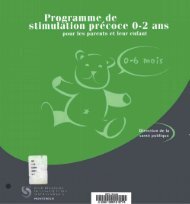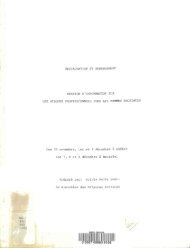le travail à l'écran de visualisation work with display units
le travail à l'écran de visualisation work with display units
le travail à l'écran de visualisation work with display units
You also want an ePaper? Increase the reach of your titles
YUMPU automatically turns print PDFs into web optimized ePapers that Google loves.
VDU USE IN SCHOOLSBengt Knave, Department of Neuromedicine, National Institute of Occupational Health, Solna*Swe<strong>de</strong>nIt is easy to un<strong>de</strong>rstand - by giving practical examp<strong>le</strong>s from everyday school life - that the introductionof computers has changed ways of basic education. Pupils spend an increasing amount of timem front of VDUs - an increase which we know will continue even more in the future.In 1984 the Swedish Government and Parliament issued a new computer education policy resolution,prompted by the rapid transformation of <strong>work</strong>ing life and the availability of low-price powerfulpersonal computers. The policy resolution provi<strong>de</strong>d for the computer science teaching time atsenior <strong>le</strong>vel of compulsory school (Gra<strong>de</strong>s 7-9) to be increased to 80 hours over a three-yearperiod starting in the 1986/87 school year. Supportive measures were also introduced to speed up<strong>de</strong>velopments in upper secondary schools, e g grants sufficed for about 500 fully equipped computerrooms in the country (10-15 VDU stations/school). As to the compulsory school <strong>le</strong>vel thebest progress has been ma<strong>de</strong> in teaching word processing, and how to set up data bases and registers.Pupils spend about 50% (40 hours per three-year period) of their computer science teachingtime in front of a VDU. In the upper secondary schools all sorts of programs are used <strong>de</strong>pendingupon subject. The average time spent at a VDU varies <strong>with</strong> education lines, the Distribution andC<strong>le</strong>rical Line, and the Economics Line topping the list <strong>with</strong> 50-60 hours per three-year period.The introduction of computer science in schools has raised some questions in the general <strong>de</strong>bate-What ought basic computer education to inclu<strong>de</strong> to prepare stu<strong>de</strong>nts for the computer society'' Inwhat gra<strong>de</strong> is computer education to begin? Are standard programs, or for the schools specially<strong>de</strong>veloped programs, to be used? What hardware is suitab<strong>le</strong> for schools? The questions are notespecially controversial; there is mostly a general agreement in standpoints from authorities, andother parties in the society. In one question, though, opinions diverge. Computer education begins,as a ru<strong>le</strong>, in Gra<strong>de</strong> 7. Several voices are now being raised, however, for a start alreadyduring the first three years in school (Age 7-9 ; Gra<strong>de</strong>s 1-3). Reference is ma<strong>de</strong> to the general receptivenessat this age and to the possibility of counteracting later sexual bias in recruitment forinfotech jobs.Questions on comfort at computer <strong>work</strong> and possib<strong>le</strong> health effects have been more or <strong>le</strong>ss absentin the <strong>de</strong>bate. By all means this <strong>de</strong>pends on the very limited VDU "exposure" of the pupils (10-20school hours per year) and the fact that there have been no signals on adverse effects from thechildren. Furthermore the locomotor system of children allows more strain than in adults, andchildrens' eyes accommodate more easily to different viewing distances.However, since we know that the amount of VDU <strong>work</strong> at school will increase rapidly there arereasons for recommending some sort of "VDU health and comfort" program aiming at possib<strong>le</strong> eyeand musculo-ske<strong>le</strong>tal discomforts. Such a program should also pay attention to dys<strong>le</strong>ctic childrenwhere prob<strong>le</strong>ms could be foreseen, and to different psycho-social effects of computerisation: Doesthe segregation into winners and losers of later <strong>work</strong> computerisation start already in school?KEYWORDS: schools, computerisation, <strong>display</strong>sANALYSIS OF ENVIRONMENTAL AND WORKING CONDITIONS AGAINST HEALTHAND VISUAL COMPLAINTS IN VDT OPERATORSRubino G. F., Di Bari A., Sonnino A., Maina G.University of Torino, Italy.The aim of this survey was to analyse a number of symptomsconnected to ocular eyestrain and subjective disor<strong>de</strong>rs connectedto the <strong>work</strong>ing conditions inon a group of 30.000 c<strong>le</strong>rk, all<strong>work</strong>ing for the Italian Te<strong>le</strong>phone Company.With the aid of an administred questionnaire, two groups,one of VDT users (about 22,000 subjects) and one of non-VDT users(about 8,000 subjects), were asked to give a personal assesmentabout the ergonomie conditions of the <strong>work</strong>ing place, that is thelighting, the microclimate, the posture, the noise and the VDTcharacteristics.The questionnaire also enquired about the ocular,muscoloske<strong>le</strong>tal and neurovegetative symptoms.All subjects were also examined by an ophthalmologist andall ocular and visual information was recor<strong>de</strong>d on to a data fi<strong>le</strong><strong>with</strong> the answers to the questionnaire.The scored symptoms obtained were processed using the factoranalysis and related to the <strong>work</strong>ing place conditions, type andhours of <strong>work</strong> and ophthalmological disturbances.The conversational operators showed the highest number ofcomplaints according to this analysis; the most acceptab<strong>le</strong> typeof VDT job was word processing.The hours of <strong>work</strong> were found to be directly related to thesymptoms; the highest preva<strong>le</strong>nce was also found in the fema<strong>le</strong>group.Relationships <strong>with</strong> age, years of VDT <strong>work</strong>, ophthalmologicalanomalies were established <strong>with</strong> all symptoms and the factors extractedfrom the statistical analysis.The main ophthalmological anomalies <strong>de</strong>termining oculardiscomfort were: miscorrected refractive <strong>de</strong>fects, heterophoriasand ocular hypertension.Non satisfactory microclimate conditions and noise weresource of the largest number of complaints, whereas there was nosignificant evi<strong>de</strong>nce in the correlation between equipment, VDTcharacteristics and the symptoms complained.Keywords:Epi<strong>de</strong>miology, Ergohphtalmology, VDTTEV 1989 — DEUXIÈME CONFÉRENCE SCIENTIFIQUE INTERNATIONALE•MONTRÉAL • SECOND INTERNATIONAL SCIENTIFIC CONFERENCE18— WWDU1989TEV 1989 — DEUXIÈME CONFÉRENCE SCIENTIFIQUE INTERNATIONAL!! • MONTRÉAL • SECOND INTERNATIONAL SCIENTIFIC CONFERENCE — WWDU 198919
















